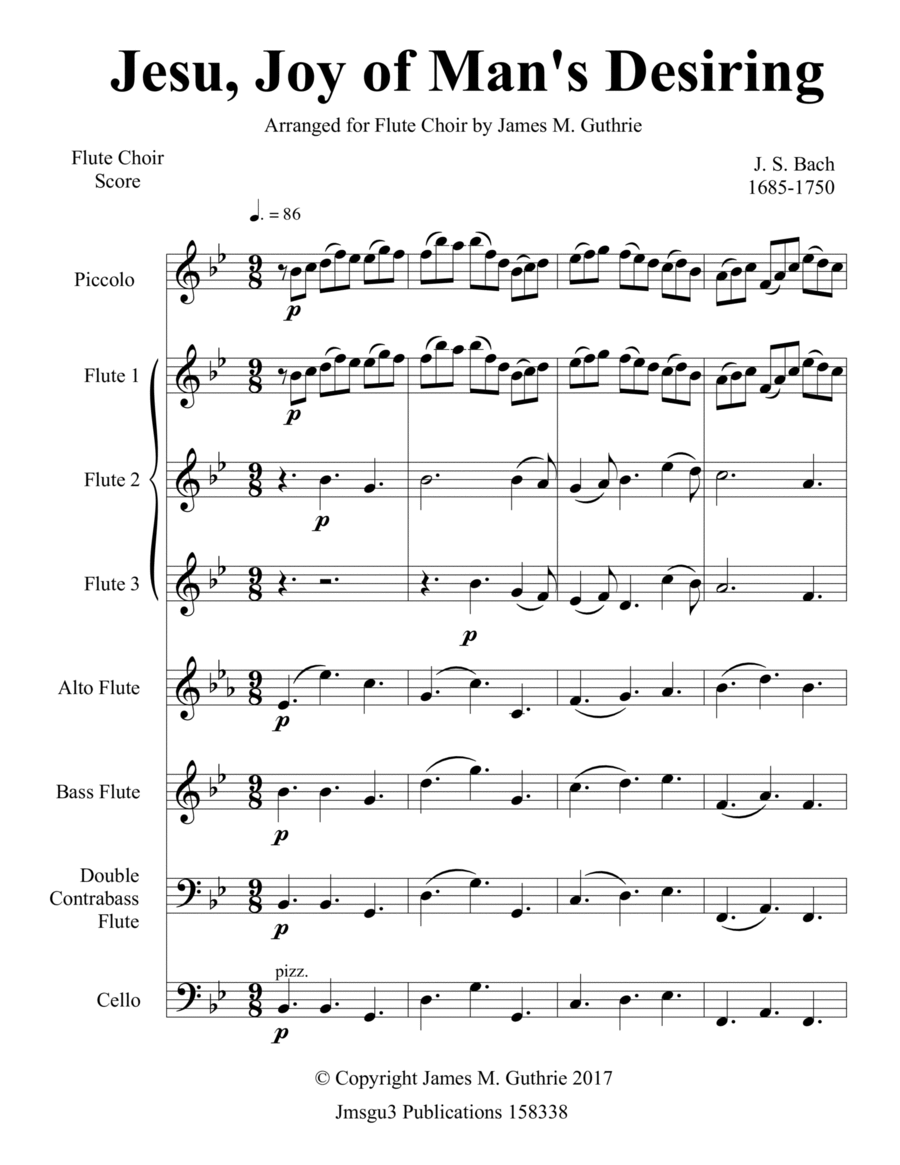Woodwind Ensemble Flute - Level 3 - Digital Download SKU: A0.548649 Composed by J. S. Bach, 1685 - 1750. Arranged by James M. Guthrie, ASCAP. Christmas,Easter,Wedding. 34 pages. Jmsgu3 #3407871. Published by jmsgu3 (A0.548649). Jesu, Joy of Man's Desiring from Bach's Cantata 147, arranged for flute choir: piccolo, 3 flutes, alto flute, bass flute, double contrabass flute (optional) and cello (optional). Score: 19 pg. Parts: 2 pg. Duration with optional repeat: 7:36 Jesu, Joy of Man’s Desiring Bach composed a cantata called Herz und Mund und Tat und Leben. Though it is the 32nd cantata, it is listed as BWV 147. Jesu, Joy of Man’s Desiring is the 10th movement of the cantata. It was customary to use previous melodies as a basis for a new work - a practice called Cantus prius factus. So, the chorale melody for this piece is a historic tune called Werde munter, mein Gemüthe. Jesu, Joy of Man’s Desiring is customarily performed at weddings, and during major church seasons such as Easter and Christmas. Bach Overview First of all, Johann Sebastian Bach is maybe the greatest composer in music history. Certainly, he was prolific. As a result, everyone has heard of his works. Furthermore, these works number well over a thousand. It seems like people are probably most familiar with the instrumental works such as the Brandenburg Concertos, and the Goldberg Variations. But, similarly famous are such noteworthy works as the Well-Tempered Clavier, the Musical Offering, and certainly the Art of Fugue. Seems like his most famous vocal works include the most noteworthy Mass in B Minor. Also, most noteworthy, though, are the St. John Passion, and certainly the Christmas Oratorio.  History Bach came from a long line of musicians and above all, composers. Consequently, he, first of all, pursued a career as a church organist. So as a result, he gained employment in various Protestant churches in Germany. For a while, he worked as a court musician in Weimar and Köthen. Here he probably developed his organ style and likewise his chamber music style. Eventually, he, therefore gained an appointment as Cantor of St. Thomas in Leipzig. Here he worked until difficulties with his employer ultimately drove him away. The King of Poland finally appointed him as court composer.  Style It seems like Bach created a fascinating new international style. He synthesized elements of the most noteworthy European music ideas into his new style. Even more, this new style was probably his synthesis of European musical rhythm and form. Furthermore, in addition to his complete mastery of counterpoint and motivic development, his sense of harmonic organization probably propelled him to the top. Revival        Mendelssohn conducted a Bach revival in the nineteenth century. His effort probably helped to re-familiarize the public with the magnitude of Bach’s works. During this period, scholars published many noteworthy Bach biographies. Moreover, Wolfgang Schmieder published the BWV (Bach Werke Verzeichnis). As a result, this is now the official catalog of his entire artistic output. The BWV number allows us to locate a work in the catalog. Sometimes scholars will simply use an S (Schmieder) as an abbreviation for BWV.
